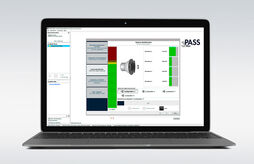MSA I & MSA II – Microphone arrays for three-dimensional noise recordings
The microphone arrays MSA I (asymmetrical) or MSA II (symmetrical) are essential system...
The microphone arrays MSA I (asymmetrical) or MSA II (symmetrical) are essential system components for operating the background noise simulation systems from HEAD acoustics. Controlled by the corresponding simulation software (3PASS lab, 3PASS flex, 3PASS reverb) both microphone arrays enable to record, equalize and realistically reproduce background noise as well as reverberation (impulse responses) – reproducibly across different laboratories or vehicle cabins.
Within this system setup, a microphone array is necessary for the automated digital equalization of the whole system. In addition to equalization, the microphone arrays allow users to record three-dimensional noise scenarios that are required for realistic tests of communication devices.
The differences between MSA I and MSA II:
- The eight microphones of MSA I are asymmetrically arranged: They cover the relevant microphone positions of mobile phones or other handheld devices when being used in handheld position at an (artificial) head
- The eight microphones of MSA II are symmetrically arranged so that they record close to both ears of an artificial head. Therefore, the microphone array is particularly suited for tests of close-to-the-ear communication devices like headphones and headsets.
In combination with the simulation software (3PASS lab, 3PASS flex, 3PASS reverb), the hardware interface labBGN (equalization, playback) as well as loudspeakers and power amplifiers, MSA I and MSA II form a powerful background noise simulation system.
The microphone arrays MSA I (asymmetrical) or MSA II (symmetrical) are essential system components for operating the background noise simulation systems from HEAD acoustics. Controlled by the corresponding simulation software (3PASS lab, 3PASS flex, 3PASS reverb) both microphone arrays...
The microphone arrays MSA I (asymmetrical) or MSA II (symmetrical) are essential system components for operating the background noise simulation systems from HEAD acoustics. Controlled by the corresponding simulation software (3PASS lab, 3PASS flex, 3PASS reverb) both microphone arrays enable to record, equalize and realistically reproduce background noise as well as reverberation (impulse responses) – reproducibly across different laboratories or vehicle cabins.
Within this system setup, a microphone array is necessary for the automated digital equalization of the whole system. In addition to equalization, the microphone arrays allow users to record three-dimensional noise scenarios that are required for realistic tests of communication devices.
The differences between MSA I and MSA II:
- The eight microphones of MSA I are asymmetrically arranged: They cover the relevant microphone positions of mobile phones or other handheld devices when being used in handheld position at an (artificial) head
- The eight microphones of MSA II are symmetrically arranged so that they record close to both ears of an artificial head. Therefore, the microphone array is particularly suited for tests of close-to-the-ear communication devices like headphones and headsets.
In combination with the simulation software (3PASS lab, 3PASS flex, 3PASS reverb), the hardware interface labBGN (equalization, playback) as well as loudspeakers and power amplifiers, MSA I and MSA II form a powerful background noise simulation system.
Highlights
- Microphone arrays are essential system components for simulation of background noises and reverberation with 3PASS lab, 3PASS flex, 3PASS reverb.
- MSA I and MSA II (in conjunction with the hardware interface labBGN) enable the recording of background noises and fully-automated digital equalization of the 3PASS-based simulation system.
- While MSA I captures the sound-field on the right side of an artificial head measurement system (e.g. mobile phones), MSA II is used to record close to both ears of an artificial head (e.g. headphones).
- In the same way, both microphone arrays can be used for hands-free and smart home applications.
Applications
- Microphone array MSA I:
- Asymmetrical microphone array with 8 microphones arranged around an artificial head in different height positions
- Captures the sound-field closed to an artificial head to cover relevant microphone positions of mobile phones
- Microphone array MSA II:
- Axis-symmetrical microphone array with 8 microphones – four on either side with different heights and distances to the head
- Captures the sound-field near both ears of an artificial head
- Optimized for testing close-to-the-ear communication devices like headphones and headsets
- Evaluation of voice recognition performance in communication devices in the presence of background noise and reverberation like e.g.:
- Mobile phones
- Smartphones (with/without display speaker)
- ANC headphones and headsets
- Voice-controlled smart home devices like smart speaker
- Voice-control systems in the vehicle
- Precise sound-field reproduction at the location of the device under test
- Equalized playback of background noise and reverberation in labs and in vehicle cabins
- Development, optimization and quality control of communication devices in the presence of background noise and reverberation
- Development, Evaluation and Optimization of complex noise reduction algorithms in communication devices
Features
- Microphone array MSA I:
- Asymmetrical microphone array with 8 microphones arranged around an artificial head in different height positions
- Captures the sound-field closed to an artificial head to cover relevant microphone positions of mobile phones
- Microphone array MSA II:
- Axis-symmetrical microphone array with 8 microphones – four on either side with different heights and distances to the head
- Captures the sound-field near both ears of an artificial head
- Optimized for testing close-to-the-ear communication devices like headphones and headsets
- Depending on the use case, a microphone array is mountable on an artificial head, tripod or a stand base
- MSA I and MSA II are designed to fit on an artificial head that complies with the international standard ITU-T P.58
- The microphone arrays can be simple and digitally connected to labBGN or SQuadriga III via a HEADlink cable
- Both microphone arrays are conveniently supported in 3PASS lab, 3PASS flex, and 3PASS reverb













